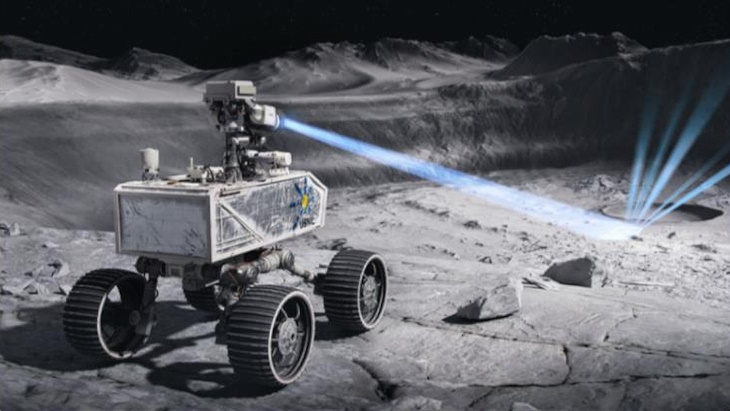An X-ray "flashlight" which would use an energy source based on Ultra Safe Nuclear Corporation's (USNC) EmberCore nuclear chargeable ceramic technology to map the lunar surface has been selected for early-stage funding in the NASA Innovative Advanced Concepts (NIAC) programme.

The 'flashlight' could be mounted on a rover to study the lunar surface (Image: Chris Morrison)
The Phase 1 study, titled EmberCore Flashlight: Long Distance Lunar Characterisation with Intense Passive X- and Gamma-ray Source, will be led by USNC Chief Engineer, Radioisotopes Chris Morrison, with support from co-investigator Thomas Prettyman of the Planetary Science Institute.
The "flashlight" will use a beam of X-rays and gamma rays that can travel over many kilometres, interact with the ground and then bounce back towards a sensor. The signal that is returned to the sensor provides an "elemental fingerprint" of information about the lunar surface and what lies beneath it. Backscattered gamma rays could be used to infer the presence of substances such as water.
The X-ray flashlight will use EmberSource, which is based on a modified version of the EmberCore nuclear chargeable ceramic USNC has been developing for use in propulsion and heating applications in space. This uses so-called “embers” made from commercially available, inert isotopes which have been charged with neutrons in a nuclear reactor.
By integrating EmberSource into a specially designed casing, X-rays that would normally be contained by shielding can be instead released through a controllable aperture. The X-rays produced by EmberSource would have a beam strength orders of magnitude greater than any previously deployed in space. Combined with the mobility of a rover, this would enable mapping of the composition of the lunar surface in greater detail than previously possible, USNC said.
"The new capabilities provided by this technology could revolutionise lunar exploration by giving us the clearest picture we’ve ever had of what resources are available on the Moon, hopefully paving the way for a sustainable human presence there," Morrison said.
The NIAC programme is designed to nurture visionary ideas that could transform future NASA missions, and the flashlight's capabilities for elemental composition analysis and operation in darkness are potentially game changing, Prettyman said. "We have several ideas for how the source and detectors would be deployed. For example, the source might accompany a rover into a permanently shadowed crater, illuminating the floor of the crater and providing power to the rover. A second rover or lander might sit outside the crater, measuring the emission of fluorescence X-rays from the interior."
The Phase 1 project is a 9-month concept feasibility study that will evaluate source parameters and possible mission architectures and will consider the development of an EmberSource X-Ray Flashlight intended to be used in two distinct locations on the moon: Shackleton Crater, and Mare Tranquillitatis, where it could be used to search for significant amounts of water and other volatile materials.
Researched and written by World Nuclear News